Whether you are still working from home or back in the office, chances are you are sitting for most of your day. All that prolonged sitting can wreak havoc on your upper back, neck and shoulders, causing pain, tension and stiffness. Getting up and stretching throughout the workday can help reduce pain and help you get more movement into your day. If your upper back feels sore at the end of a long day, it might be time to give one of the following stretches a try.
Fancy ergonomic chair or not, spend any length of time at your desk—or slumped on the sofa with your laptop or phone—and you’ll start to feel the effects. Tension between the shoulder blades, tightness in the upper back and shoulders, and pain radiating along the neck are all symptoms of sitting for too long. Not to mention, you may notice other side effects like bad posture, neck strain, circulation issues, and even shallow breathing. And you’re not alone: up to 85% of Canadians have experienced back pain at some point in their lives, with up to 55% of Canadians saying they have chronic pain. Factor in our largely sedentary lifestyles, and it starts to make sense.
Here’s the good news. In addition to keeping our muscles flexible and strong, stretching can help alleviate pain and tension so you can get on with your life. We spoke with Lynelle McSweeney, D.C., a holistic chiropractor in Reno, Nevada, for her input on the value of stretching and the most effective stretches for upper-back pain.
Best stretches for upper back pain.
Effectively stretching the upper back to relieve tightness and tension doesn’t have to be overly complicated. You can do almost all of these stretches right at your desk or sofa, in just a few minutes. And that’s a good thing because you don’t want to overdo it. McSweeney recommends incorporating these stretches several times a day at most. “Over-aggressive stretching can exhaust the muscles and actually increase pain and tension,” she says. “In extreme cases, too much or too-rigorous stretching can damage ligaments and muscles, too.”
As you perform these stretches, try to focus on moving with the breath—gently deepening the stretch on the exhale and relaxing slightly on the inhale. Never force a stretch, and always listen to your body. The goal here is to release tension, so don’t hurt yourself.
1. Levator scapulae stretch
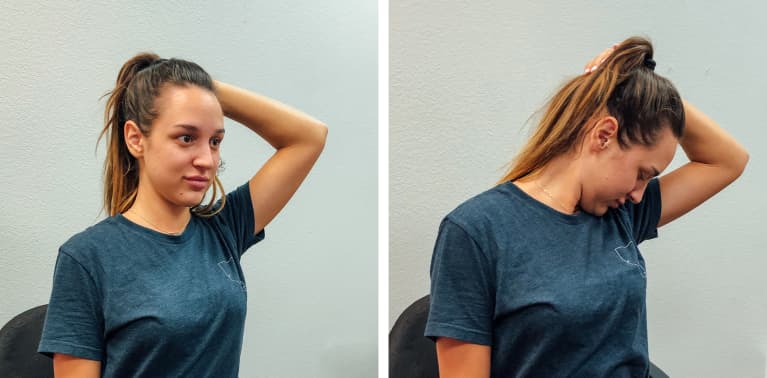
- Begin from a seated position, with back straight and shoulders back, right hand holding the bottom of your chair.
- With your left hand, reach up and over to grasp the back of your head.
- Drop your chin to your chest, then rotate the head toward the left shoulder, using your left hand to gently pull your head toward your left armpit.
- Comfortably deepen the stretch as you inhale and slightly relax on the inhale, for 20 to 30 seconds.
- Repeat on the other side.
2. Upper butterfly stretch
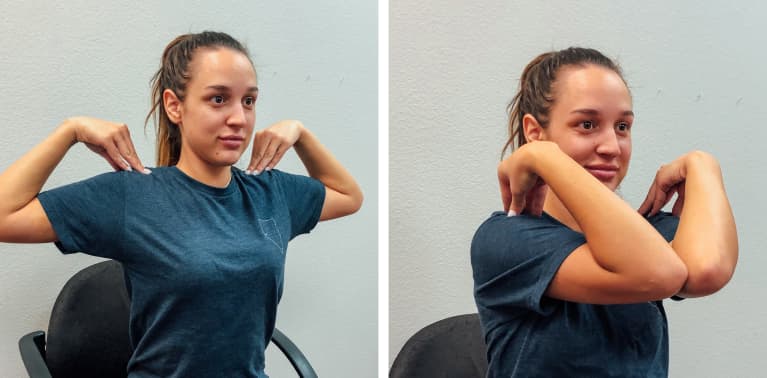
- Sitting up straight, lightly touch your fingertips to your shoulders with elbows pointed out to the sides.
- Keep fingers in place, then exhale and slowly move the elbows forward until they touch, remembering to keep the spine straight.
- Inhale, and move elbows back out to the starting position. Repeat a few times.
3. Lat side stretch
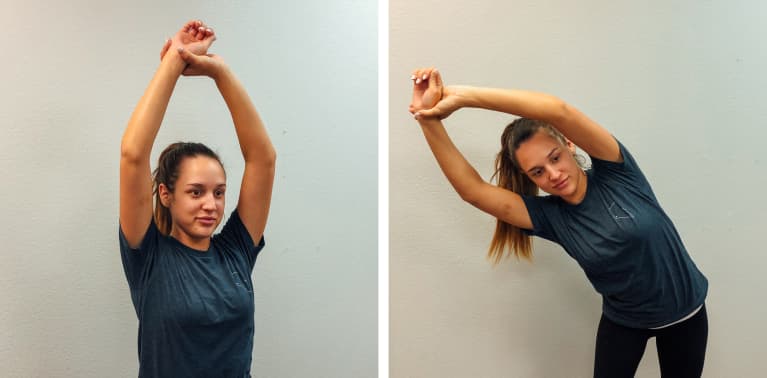
- From a standing position and with arms raised overhead, grasp the left wrist with the right hand.
- Gently lean to the right with a rainbow movement, assisting with the stretch by gently pulling on the wrist.
- Hold for a few beats, breathing evenly, and then repeat on the other side.
4. W retract
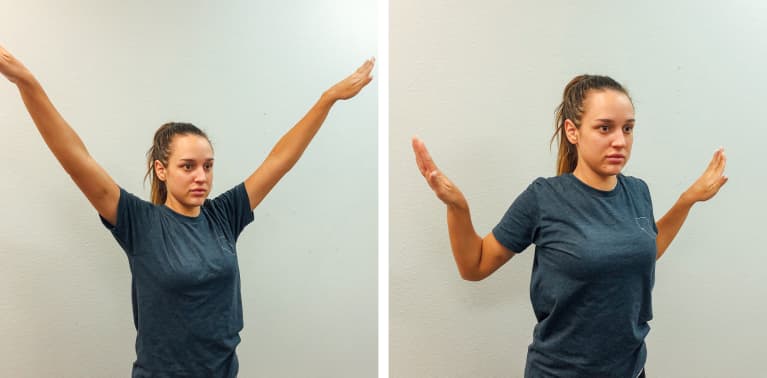
- From a standing position, extend arms up at an angle.
- Slowly pull them down and into a 90-degree angle, making a W shape with the arms by retracting them to the stomach area.
- Squeeze the shoulder blades and hold for two counts. Then release, slowly moving back up to the starting position. Repeat a few times.
5. Seated cat-cow
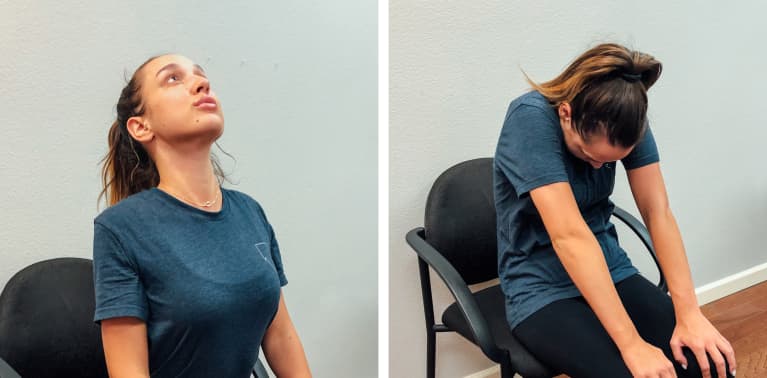
- Start seated on the edge of your chair, feet hip-distance apart, hands on knees. Inhale, lift chin and chest, expand across chest, and pull the shoulders back, gazing upward.
- Exhale, rounding through the spine, tucking the chin, release through the neck.
- Cycle through five movements.
6. Child’s pose
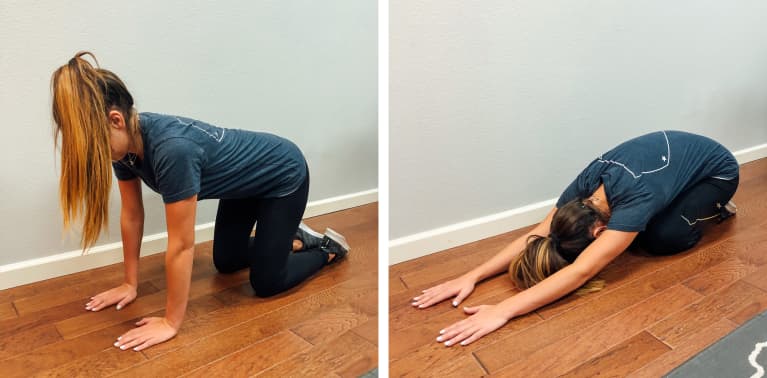
- Start on your hands and knees.
- Turn the toes in and bring the hips back, bending the knees and straightening your arms.
- Relax your head, and deepen the stretch comfortably on the exhale, arms reaching out on the ground in front of you.
- Relax the stretch on the inhale.
The takeaway
Making time for these stretches can help alleviate tension in the upper back as it builds throughout the day. But stretching alone isn’t a magic bullet that will ward off the effects of a day spent on your rear. Seeing a chiropractor for regular adjustments can help keep your spine properly aligned and help prevent pain in the first place! Make a point of getting up and moving at least once an hour, staying hydrated, exercising consistently, and you guessed it, stretching.
Please remember that it is important to consult your doctor before adding new stretches or exercises to your routine. Email us at info@evolvevancouver.ca to learn more or to book an appointment with one of our experienced chiropractors.